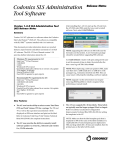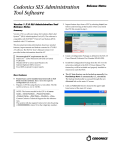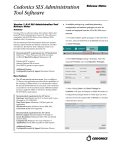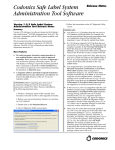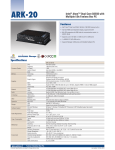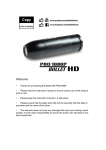Download AMK801 - Ariesys
Transcript
AMK Rack LCD Console User Reference Manual Introduction Thank you for purchasing AMK LCD console drawer. AMK LCD console drawer can save your MONEY, TIME, SPACE, EQUIPMENT and POWER. PCs or Servers can be controlled from One Keyboard, Mouse and LCD Monitor. AMK LCD console drawer is loaded with features such as 19” Rack Mount Size, Daisy Chain up to eight units, On Screen Display Menu, Password security, Searching PC server name, Hot key Control, Front Panel Push Button and Auto Scan Control. It has complete keyboard and mouse emulation for simultaneous PCs boot-up process. Features Meets EIA310c & IEC-3 specifications 1U, built-in 17” or 19” LCD Monitor, 1/8/16 port PS2 or Combo (PS2 & USB) KVM switch in 19” rack mount cabinet. Single Rail or Dual Rails Built-in rail self-locking device Support DOS, Win3.X, Win95/98/98SE/2000/ME/XP, WinNT, Netware, SCO Unix, HP Unix, Linux Hot Plug - Add PCs or Remove Connected PCs for Maintenance no need to power down the KVM switch or PCs. No Software Required - easy PC selection via On Screen Display Manual, Push Buttons and Hot Keys PS2 KVM support eight characters password protection, Combo KVM support two layers password security protection. Auto Scan Mode for monitoring PCs and flexible Scan time from 5~99 seconds Keyboard status restored when switching PCs LED Display for easy status monitoring Buzzer sound for switching port confirmation. Using Standard VGA, Keyboard and Mouse cable. Built-in one extra daisy chain port and no waste any PC port 2 Package Contents Model No.: AMK501/ AMK701/ AMK801 Package Content QTY AMK 1 port 1 User’s manual 1 Power Cord 1 Bracket 2 KVM Cable 1 Foam with Box 1 Screw Pack 1 Model No.: AMK508/ AMK708/ AMK808 Package Content QTY AMK 8 port KVM Switch 1 User’s manual 1 Power Cord 1 Bracket 2 KVM Cable 8 Foam with Box 1 Screw Pack 1 Model No.: AMK516/ AMK716/ AMK816 Package Content QTY AMK 16 port KVM Switch 1 User’s manual 1 Power Cord 1 Bracket 2 KVM Cable 16 Foam with Box 1 Screw Pack 1 Note: AMK models with DC power supply do not include power cord. 3 Technical Specifications (Single Rail) 1U, Single rail, Rack LCD Console Drawer Specification for AMK 801/808/816 Model No. AMK801 AMK808 PC Port Drawer Design LCD Display Keyboard/ Mouse Construction Power supply Physical Security Protection Power Consumption Operation Temperature Storage Temperature Humidity Weight (kg) Dimension (cm) Compliance 1U, Single rail, Rack LCD Console Drawer Specification for AMK 501/508/516 Model No. AMK501 AMK508 PC Port Drawer Design LCD Display Keyboard/ Mouse Construction Power supply Physical Security Protection Power Consumption Operation Temperature Storage Temperature Humidity Weight (kg) Dimension (cm) Compliance AMK516 1 8 16 1U, Single Slide Rail self-locking device for 19” rackmount 17.3”, 1600x 900 resolution with tempered glass Option: 17.3”, 1920x 1080 resolution 104-key Industrial keyboard with touchpad Heavy-duty Steel Built-in 60W, 90~264VAC Auto Switch, Operating Temp.: -20~70°C 2 thumb screws to secure LCD monitor Tempered glass protect LCD screen 3 watts stand-by, 25 watts in-use 0~50℃( 32 ~ 122°F) -20 ~ 60℃( -4 ~ 140°F) 0~90%, Non-Condensing 10 kg 11 kg 11 kg 442.4 X 44 X 410mm 442.4 X 44 X 520mm 442.4 X 44 X 520mm CE, FCC Class A, RoHS AMK5 series: 2 thumb screws to secure LCD monitor 4 AMK816 1 8 16 1U, Single Slide Rail self-locking device for 19” rackmount 17” or 19”, 1280x 1024 resolution with tempered glass 104-key Industrial keyboard with touchpad Operating life of keys: 8 million cycles Heavy-duty Steel Built-in 60W, 90~264VAC Auto Switch, Operating Temp.: -20~70°C Key locking Mechanism Tempered glass protect LCD screen 3 watts stand-by, 25 watts in-use 0~50℃( 32 ~ 122°F) -20 ~ 60℃( -4 ~ 140°F) 0~90%, Non-Condensing 12 kg 13 kg 13 kg 442 X 44 X 480mm 442 X 44 X 590mm 442 X 44 X 590mm CE, FCC Class A, RoHS Technical Specifications (Dual-Rail) 1U, Dual-Rail, Rack LCD Console Drawer Specification for AMK 701/708/716 Model No. AMK701 AMK708 PC Port Drawer Design LCD Display Keyboard/ Mouse AMK716 Construction Power supply Physical Security Protection Power Consumption Operation Temperature 1 8 16 1U, Dual Slide Rail self-locking device for 19” rackmount 17” or 19”, 1280x 1024 resolution with tempered glass 104-key Industrial keyboard with touchpad Operating life of keys: 8 million cycles Heavy-duty Steel Built-in 60W, 90~264VAC Auto Switch, Operating Temp.: -20~70°C Key locking Mechanism Tempered glass protect LCD screen 3 watts stand-by, 25 watts in-use 0~50℃( 32 ~ 122°F) Storage Temperature -20 ~ 60℃( -4 ~ 140°F) Humidity Weight (kg) Dimension (cm) Compliance 0~90%, Non-Condensing 12 kg 13 kg 442 X 44 X 480mm 442 X 44 X 590mm CE, FCC Class A, RoHS KVM switch 8-port 13 kg 442 X 44 X 590mm 16-port PS2 KVM Port Connection KVM Port Max. Port Port Selection Connectors KVM Port Console Port Daisy Chain Switch LED KVM Cable Power Port Selection Reset Power LCD on/off LCD control Operation Power Keyboard Lock COMBO KVM PS2 KVM COMBO KVM 8-Port 16-port Daisy Chain up to 8 levels to support Daisy Chain up to 8 levels to 120 servers support 128 servers 8x Front Push Buttons, 16x Front Push Buttons, OSD Manu, Hotkey OSD Manu, Hotkey 8x DB-15 8x DB-15 16x DB-15 16x DB-15 1x DB-15, 1x DB-15, 2x USB 2x USB 1x DB-15, 1x DB-15, 1x DB-15 1x DB-15 PS2 KB/MS PS2 KB/MS 1x 3-prong AC Socket 8x Front Push Buttons 16x Front Push Buttons 1x push button 1x Rocker Switch 1x Front standby Push button 4x LCD Adjust push button 8 16 8 16 1x Num Lock, 1x Caps Lock, 1x Scroll Lock 8x 1.8m PS2 KVM 8x 1.8m USB 16x 1.8m PS2 16x 1.8m USB cable cable KVM cable cable Option: 80W, 24~48 VDC power supply Touch screen: AMK501/ AMK701/ AMK801 only DVI interface: AMK501/ AMK801 only 5 Cable Diagrams USB KVM cable: VGA D-sub 15 pin to VGA D-sub 15 pin and USB connector 1.8m USB cable, P/N: 68103-03001-01 3.0m USB cable, P/N: 68103-03002-01 PS2 KVM cable: VGA D-sub 15 pin to VGA D-sub 15 pin and PS2 KB/MS connector 1.8m PS2 cable, P/N: 68103-01001-00 3.0m PS2 cable, P/N: 68103-01002-00 5.0m PS2 cable, P/N: 68103-01003-00 Rear Panel of AMK801-PB/ AMK801-UB/ AMK701-PB/ AMK701-UB: Rear Panel of AMK808-PB/ AMK708-PB (PS2 KVM): Rear Panel of AMK808-CB/ AMK708-CB (PS2& USB KVM): Rear Panel of AMK816-PB/ AMK716-PB (PS2 KVM): Rear Panel of AMK816-CB/ AMK716-CB (PS2& USB KVM): 6 Rackmount Installation 1. Find the property position to screw these two extension brackets with the ears and both side onto the server rackmount first. 2. Lift & push the AMK inside the rackmount, and screw between bracket and AMK with 4 screws. 3. Mount the front ears of AMK main body onto the server rackmount. 7 Installation/Operation Before installation, please make sure all of peripherals and computers have been turned off. This example of installation is based on AMK808 and you also can think that all AMK series have the same installation procedures Step 1 Insert the RACK LCD Console Drawer into the 19” rack cabinet in the desired position. Attach the 2x rear support brackets and extending into the proper length of the cabinet depth. And secure the 2x brackets on each side with the supplied screw. Secure the rear and front rack mounting to properly mount and fix its position into the cabinet Step 2 Connecting the KVM cable, VGA D-sub 15 pin was connected to the rear of drawer, and VGA Dsub 15 pin and PS2 KB/MS or USB was connected to PC or server. For the AMK808-CB/ AMK816-CB both PS/2 and USB type can be used with the KVM, just choose the desire type to match with your system, the KVM accepts both. Step 3 Double-check all of the connections. You can check the color of keyboard and mouse connector to make sure the keyboard and mouse cables go to the correct ports. Step 4 Repeat step 5 to 7 for the remainder of the computers. Step 5 Connect the AC power cable into rear of the drawer unit. Turn on the drawer unit main power on the back of the chassis Step 6 Turn on all the computers and then boot them one by one. Switch on your monitor make sure every monitors can be display and then set the computer’s Monitor power always on. In order to keep the connection form KVM to the Computers. 8 PS2 KVM Connection The power on state of 8/16 port PS2 KVM switch: When you power on KVM switch, it will ask you the password, the default password value is eight zero –“ 00000000 “. Please key in eight zero and enter the same value at retype field. Note: Before you are not familiar with the operation of OSD menu, please don’t change the password – i.e. keep default eight zero (00000000) value. Otherwise, if you have set the password and unfortunately forget the password, you need send it back to your distributor for maintaining the password. LED Indication: You can press the button in order like mentioned-above diagram. When you select one of sixteen PC ports and this PC is powered on, the selected port LED is lit. When you select one of sixteen PC ports and this PC is shut down or disconnected a PC, the selected port LED will flash. Reset Button ( (Bank Select) and (Port Select) ): To press both “select” button and “bank” button of master bank simultaneously can reset KVM switch. This reset action will not only return KVM switch back to initial state --- Check the password, but also re-check all of slave banks which connected to mast KVM Switch. If you add a new KVM Switch as a slave bank, please use reset button of master KVM Switch to automatically assign a new ID to it. You can view this new slave bank go through OSD menu. The PC ports of KVM Switch do not be reset by reset command. Keyboard Hot Key Commands: You can also conveniently command AMK KVM switch by switching ports through simple key sequences. To send commands to AMK KVM switch, the “SCROLL LOCK” key must be pressed twice within 2 seconds. You will hear a beep for confirmation and the keyboard is in hot key mode. If you have not pressed any key in hot key mode within 2 seconds (It means to key in any key follows up “Scroll Lock” “Scroll Lock” key ), the keyboard will back to under Operation System control state. Below are the different hot key commands: Within 2 seconds Scroll Lock + Scroll Lock + ↑ Scroll Lock + Scroll Lock + ↓ Scroll Lock + Scroll Lock + Page Up = Previous Channel = Next Channel (Note: You also could press “up arrow key” or “down arrow key” longer time to speed up selecting the destination port) = Previous Bank 9 Scroll Lock + Scroll Lock + Page Down = Next Bank To select PC port: Port No Port No. 1~4 (4 port) 1~8 (8 port) 1~16 (16 port) Scroll+ Lock + Scroll Lock + Bank No Scroll Lock + Scroll Lock + B = Beeper (Note: The default Beeper function is ON and beeper control is only for available for Scan Mode) Scroll Lock + Scroll Lock + S = Auto Scan To get out of Auto Scan Mode, Press any key or SPACE bar. Scroll Lock Scroll Lock ROM REFLASH + Scroll Lock + R + Scroll Lock + F = OSD default value (Note: Not including password) = Search the same PC name (Note: Search PC name starting from 1st PC port) FIND:█ Scroll Lock + Scroll Lock + Space bar = On Screen Display Menu Example: A. To access a computer attached to Port 6 of the fifth Bank. You can press through hot key as: Scroll lock + Scroll lock + “5” + “0” “6” B. To access a computer attached from Bank 3 to Bank 4, You can press through hot key as: Scroll lock + Scroll lock + Page Down Note: Bank no. and Port no. selection must be made using the numeric keys on the keyboard. Numeric keys on the keypad are not available as a hot key command. 10 PS2 KVM OSD Operations When you pop up the OSD menu window go through the hot key, you will see the following small window on your monitor. BANK : 1 01 a. The 1ST line bar is Bank no. SYSTEM 01 02 ☼SYSTEM 02 03 ☼SYSTEM 03 04 ☼SYSTEM 04 05 ☼SYSTEM 05 06 07 SYSTEM 07 08 ☼SYSTEM 08 09 SYSTEM 09 11 ☼SYSTEM 11 10 SYSTEM 10 1 12 ☼SYSTEM 12 13 14 ☼SYSTEM 14 SYSTEM 13 15 ☼SYSTEM 15 16 SYSTEM 06 SYSTEM 16 OSD : 1 0 SEC. CHANGE PASSWORD SCAN: 1 0 SEC. CONSOLE ON/OFF ESC : QUIT ENTER :COMPLETE TAB : NEXT INSERT :EDIT /: SELECT PORT PgDn/PgUp: BANK SELECT b. The 2nd block is your PC system name list. You will find the system number list from 01 to 04 (if the current box is 4 port) or from 01 to 8 (if the current box no. is 8 port) or from 01 to 16 (if the current box no. is 16 port). You can define your PC name in maximum 8 characters. The factory default of 16 port KVM switch PC name is from “SYSTEM 01”, “SYSTEM 02” ,…, “SYSTEM 16” and 8 port KVM switch is from “SYSTEM 01”, “SYSTEM 02”,…, “SYSTEM 08”. Besides, the sun symbol “☼ “near to the PC name represents the PC system is powered on. c. To use up arrow key “ “ or down arrow key “ “ to select port for destination PC name. After you have selected the PC port already, you can press the ENTER Key to switch the PC port you want immediately To use “ PgUp “ key or “ PgDn” key for selecting previous or next Bank no. (or Box No.) BANK : 1 01 SYSTEM 01 02 ☼SYSTEM 02 To press “INS” key for editing PC name. After finishing the edit, please press “Enter “key for saving information. To use “ Tab “ key to select items like Bank, OSD, SCAN, CHANGE PASSWORD, CONSOLE ON/OFF, etc… 11 a. The “OSD: 10 SEC” means that the OSD windows display 15 ☼SYSTEM 15 16 SYSTEM 16 or PC system name exists 10 sec. on your monitor. You can OSD : 1 0 SEC. CHANGE PASSWORD modify it from 05 sec to 99 sec. The factory default value SCAN: 1 0 SEC. CONSOLE ON/OFF is 10 sec.. b. The “SCAN TIME” means that ESC : QUIT ENTER :COMPLETE scan interval from one PC port to next PC port. The default TAB : NEXT INSERT :EDIT SCAN time is 10 sec and the maximum scan time is 99 sec. c. The “CHANGE PASSWORD” is for user to avoid all PC systems to be intruded by the other person. The default password is 8 digits “00000000 “. ENTER PASSWORD : █ ESC : QUIT ENTER : COMPLETE There is an enter password window showed out when you select this item and then press the Enter. The maximum password is eight digits. After you key in the password already and press the Enter key, there is another window for confirming your typed password. ENTER NEW PASSWORD : █ ESC : QUIT RETYPE NEW PASSWORD : █ ENTER : COMPLETE ESC : QUIT ENTER : COMPLETE You need to retype the password again for rechecking your previous password is matched or not. d. The “CONSOLE ON/OFF “means to manage the console of KVM switch. If you select “CONSOLE ON “, it means that any user can use the console. If you select “CONSOLE OFF “(factory default OFF state), it means that any user will not be allowed to use the console unless you enter the password. When you enter the password already and pass the KVM switch authentication, the CONSOLE will be set to ON. After you finish using KVM switch, please don’t forget to set up CONSOLE ON state to OFF state. Besides, if current CONSOLE is ON state and you reset KVM switch, the CONSOLE will be set up ON state back to OFF state. e. When you finish the set up of PC name and get out of OSD setting mode, you will find the PC name showed at the up-left corner of monitor. Now, you can use “ESC” key to clear the message right away if you don’t need it. 102 ☼SYSTEM 02 f. If you want OSD returning back to factory default value, you can execute “SCROLL LOCK”, “SCROLL LOCK”, “R” keys in order. The Seven segment LEDs on the front panel will be flashed during the refresh process. ROM REFLASH When the OSD value back to default setting, the seven segment LEDs on the front panel will stop flashing 12 COMBO KVM Connection The rear section of the unit will have a series of connections for connecting to systems 8 Ports 16 Ports AC Power Plug Local Console Keyboard / Mouse Port Daisy Chain KVM Ports for Host Connecting KVM Ports for Host using PS2/ USB connection. Connect single ended D-Sub end to KVM port and other end composing of VGA D-Sub, PS2/ USB Keyboard and Mouse to corresponding ports on the system. You can connect a local console port to operate the KVM bypassing the built-in LCD and keyboard/touchpad through the rear local console port. Connect the VGA D-Sub connector and USB keyboard and USB mouse to the port marked. 13 You can connect additional KVM port by adding additional KVM switches and connecting between them a daisy chain cable. The control will be from the primary KVM by changing banks selection. COMBO KVM OSD Operations When powering up the unit it is require that you provide authentication to access the KVM control for all system connected to the unit. The default user name is 00000000 and the default password is 00000000 After login the screen will display status of the current setting. This will give you information regarding the port (name) and key setting. Pressing any key will remove the status display. You can bring up the KVM OSD by pressing the Cap Lock key twice and then Space Bar. 14 The first page display will show the OSD menu that allows you to choose the main general options you would like to proceed. Following are list of function key to access each of the action. 15 The bottom right portion of the OSD gives the status of the user login and setting. By going into the menu, you will receive a new list of functions. The language selection allows you to choose the desired display language for reference. **NonLatin based language are for display purpose only and not for editing 16 The port name edit allow you to assign naming to each of the port connected to better recognize and categorize based on your needs. The port search allows you to find by the name which you have assign to a port. This is especially useful when you have multiple banks of ports. By searching a wildcard *, it will return all port names. The user security menu allows you to assign 1 supervisor and up to 8 users. User name and password are assigned here. 17 The access list allows you to assign user right to each port. Only the supervisor can configure the access list. Use the Enter key to toggle the port right, where O means enable and X means disable. The hot-key menu allows you to set the hot key used to bring up the OSD. The time settings menu allows you to set the auto-scan time for host port by port. 18 The OSD mouse menu allows you to set the OSD cursor mouse speed. COMBO KVM Hot Key Operation (AMK808/ 816/ 708/ 716-CB) Hot key can be provides convenient short cut to access functions similar to the OSD menu. You can have a full command of the KVM switch through a simple sequence of key. To access, you must press the hotkey (default Caps Lock) twice within 2 seconds. You will hear a beep sound confirming activation, then pressing another command key to submit. If you do not press any command key 2 second afterward it will escape back to normal mode. 19 Troubleshooting 1. Ensure that all cables are well seated. Label all of cables with the number for each respective computer to avoid confusion. 2. The recommended VGA cable distance is 5 meters maximum without ghosting and degradation. Normally, the cable length is based on driver capacity of your VGA card. If you need longer VGA cable, please use VGA extender to accomplish your applications. 3. The recommended PS2 cable distance is 5 meters maximum. Normally, the cable length is based on driver capacity of your motherboard PS2 port. If you need longer PS2 cable, please use PS2 extender to accomplish your applications. 4. The Power Jack polarity is center positive and the power adapter need be DC12V, 1A . 5. Don’t press any keys on the keyboard while the selected computer is booting up. Otherwise, it might cause the keyboard error or keyboard is not detected at PC side. 6. The computer boot up fine, but keyboard doesn’t work Make sure the keyboard works when directly plugged into the computer. Try a different keyboard, but use only 101, 102 or 104-key keyboard. 7. The Mouse is not detected during PC boot up. Make sure the mouse works when directly plugged into the computer. Make sure the mouse is a true PS/2 mouse. A combo mouse will work just as long as it is set for PS/2 mode with the correct adapter. Try a different mouse. Avoiding moving the mouse or pressing the mouse buttons when switching ports. Avoiding switching ports during shutting down the PC process. When you switch one PC port to another PC port, the best scan time setting need to be set to 5 sec. or more. Normally, the VGA monitor change one resolution mode to another will take one or two seconds. So, the scan time is not recommended to below 5 seconds. 8. The power switch is off, but the switch still works fine or power adapter is unplugged from the switch, but the switch still works fine. KVM Switch unit draws the power source from power adapter and all PC’s PS2 port. Some PC’s PS2 port can support enough power for the switch, but some PC’s PS2 port ( like laptop, notebook computer…etc.) is unable to supply enough power for the switch. In order to make sure the system can work steadily, please do not set power switch to off state or remove the power adapter from the switch. Although the PCs connected to KVM Switch unit are able to support enough power to the stand alone switch, KVM Switch unit still needs a power adapter for daisy chain more banks. 9. 20 If forgetting the “password” you typed, please contact your supplier.





















